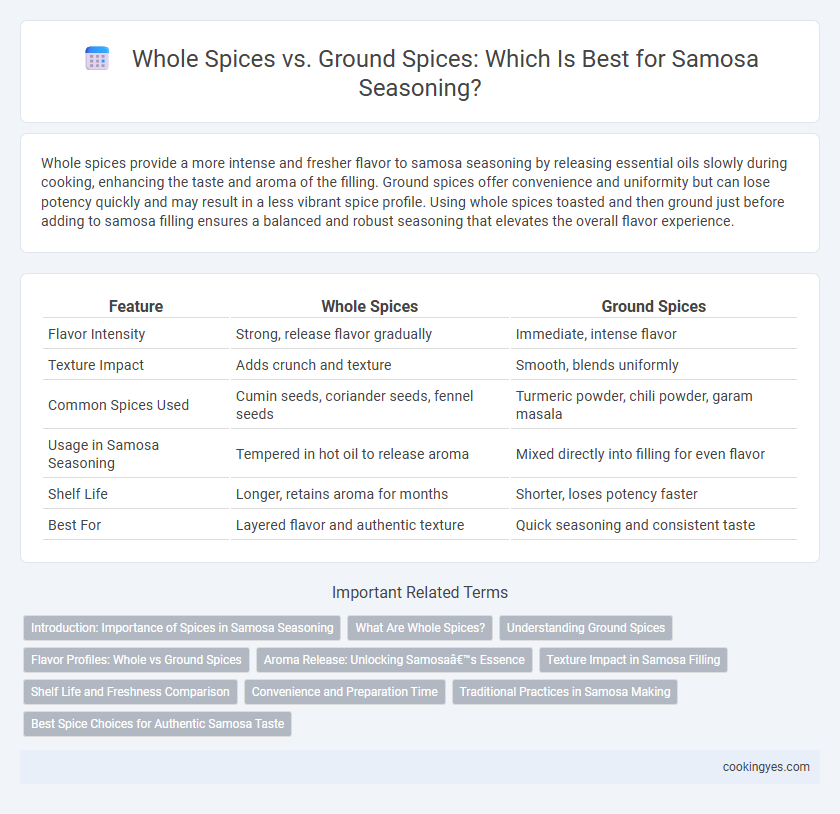Whole spices provide a more intense and fresher flavor to samosa seasoning by releasing essential oils slowly during cooking, enhancing the taste and aroma of the filling. Ground spices offer convenience and uniformity but can lose potency quickly and may result in a less vibrant spice profile. Using whole spices toasted and then ground just before adding to samosa filling ensures a balanced and robust seasoning that elevates the overall flavor experience.
Table of Comparison
| Feature | Whole Spices | Ground Spices |
|---|---|---|
| Flavor Intensity | Strong, release flavor gradually | Immediate, intense flavor |
| Texture Impact | Adds crunch and texture | Smooth, blends uniformly |
| Common Spices Used | Cumin seeds, coriander seeds, fennel seeds | Turmeric powder, chili powder, garam masala |
| Usage in Samosa Seasoning | Tempered in hot oil to release aroma | Mixed directly into filling for even flavor |
| Shelf Life | Longer, retains aroma for months | Shorter, loses potency faster |
| Best For | Layered flavor and authentic texture | Quick seasoning and consistent taste |
Introduction: Importance of Spices in Samosa Seasoning
Whole spices like cumin seeds, fennel, and coriander pods release aromatic oils during tempering, enhancing the samosa's flavor and texture with bursts of freshness. Ground spices such as turmeric, chili powder, and garam masala provide consistent, deep color and a well-blended taste throughout the potato or vegetable filling. The balance between whole and ground spices is essential for achieving the signature warm, complex, and vibrant seasoning that defines authentic samosas.
What Are Whole Spices?
Whole spices are the seeds, bark, or pods used in their natural, unprocessed form, providing more intense and prolonged flavor release in samosa seasoning. Common whole spices for samosas include cumin seeds, coriander seeds, cloves, and cinnamon sticks, which are often toasted or fried in oil to enhance their aromatic qualities. Using whole spices instead of ground spices allows for a fresher, more complex taste and helps prevent the spice blend from turning bitter or losing potency during cooking.
Understanding Ground Spices
Ground spices enhance samosa seasoning by releasing intense flavors more quickly compared to whole spices, which require longer cooking to infuse their essence. Using ground spices like cumin, coriander, and garam masala ensures a consistent, well-blended taste throughout the filling. Their fine texture integrates seamlessly, creating a robust and aromatic profile that defines authentic samosa seasoning.
Flavor Profiles: Whole vs Ground Spices
Whole spices in samosa seasoning offer a robust, aromatic flavor that slowly infuses oil during frying, enhancing the layered taste of the filling. Ground spices provide an immediate, intense burst of flavor, evenly distributing spice notes throughout the mixture for a consistent seasoning. Utilizing whole spices like cumin seeds or cloves creates a subtle texture contrast, while ground spices blend seamlessly, intensifying the overall savoriness of the samosa.
Aroma Release: Unlocking Samosa’s Essence
Whole spices retain essential oils longer, releasing intense and fresh aromas when fried, which enhances samosa seasoning's depth. Ground spices, while convenient, lose volatile compounds quickly, resulting in a milder scent and less vibrant flavor profile. Using whole spices cracked or freshly ground just before cooking ensures optimal aroma release, unlocking the true essence of samosas.
Texture Impact in Samosa Filling
Whole spices in samosa seasoning release bursts of flavor during cooking, adding a textured crunch to the filling, enhancing the eating experience with subtle contrasts. Ground spices, on the other hand, blend seamlessly into the mixture, creating a uniform taste and smoother texture that coats each bite evenly. Choosing between whole and ground spices directly affects the filling's mouthfeel, balancing complexity and cohesion in traditional samosa recipes.
Shelf Life and Freshness Comparison
Whole spices used in samosa seasoning maintain freshness and potency much longer than ground spices, often lasting up to several years when stored properly. Ground spices, due to increased surface area, lose flavor and aroma rapidly, typically within six months, diminishing the rich taste essential for a perfect samosa. Choosing whole spices and grinding them fresh preserves essential oils and enhances overall seasoning quality, ensuring a vibrant, aromatic filling.
Convenience and Preparation Time
Using whole spices for samosa seasoning enhances flavor complexity but requires longer preparation and roasting time to release essential oils. Ground spices offer convenience with immediate usability, significantly reducing preparation time and simplifying the cooking process. Choosing ground spices is ideal for quick, consistent seasoning, while whole spices suit traditional methods emphasizing freshness and depth.
Traditional Practices in Samosa Making
Traditional samosa recipes favor whole spices such as cumin seeds, fennel seeds, and cloves for seasoning, as these release a robust aroma and distinctive flavor when fried in hot oil or ghee before adding the filling. Using whole spices preserves essential oils and enhances texture, contributing to the authentic taste that defines classic samosas. Ground spices tend to lose potency quickly and are often added later for convenience, but they lack the depth and complexity achieved with traditional whole spice tempering methods.
Best Spice Choices for Authentic Samosa Taste
Whole spices like cumin seeds, coriander seeds, and black peppercorns provide a fresher, more aromatic base for authentic samosa seasoning, releasing intense flavors when lightly toasted. Ground spices such as turmeric, garam masala, and chili powder offer convenience and a consistent heat level but may lack the depth and complexity of flavor found in freshly toasted whole spices. Combining both whole and ground spices ensures a balanced, robust taste profile essential for crafting traditional, flavorful samosas.
Whole spices vs Ground spices for samosa seasoning Infographic

 cookingyes.com
cookingyes.com